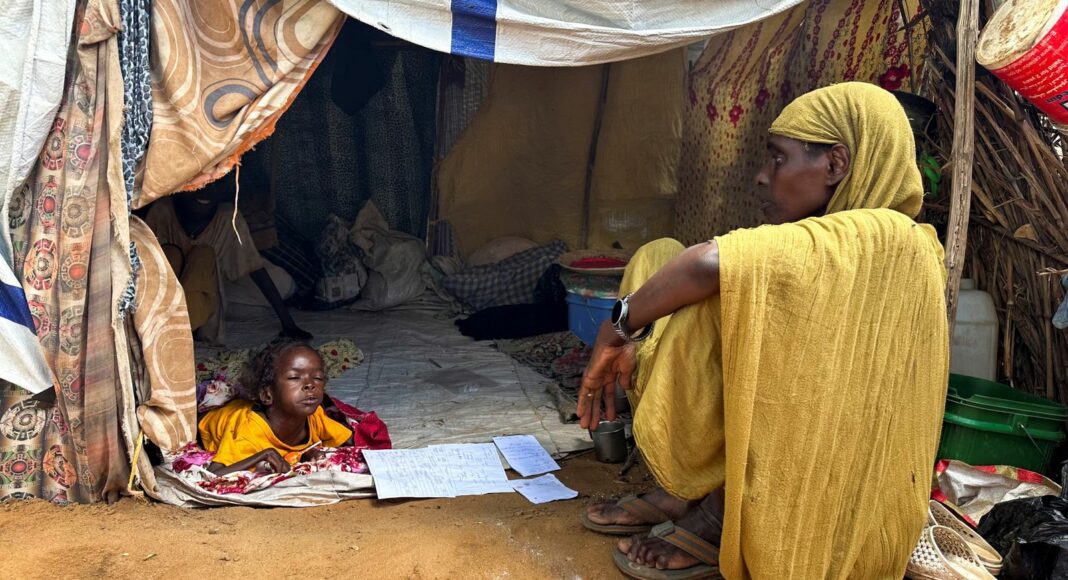About half a million residents in the Zamzam displacement camp, North Darfur, are living in extreme strife and in a state of famine. A doctor working there describes the humanitarian situation as “catastrophic”.
“People are dying from hunger,” says Dr Nasr Yousif Rajab, the camp’s health rapporteur and a member of the local Emergency Response Room (ERR). “I personally witnessed an elderly man, a woman in her first month of pregnancy and an infant of breastfeeding age die from hunger in front of me.”
But experts say this famine – officially declared by the Famine Review Committee (FRC) earlier this week – was “100% preventable” and is “entirely man-made”.
Araf, a young woman now living in Zamzam with her surviving family, says: “Missiles fell on our homes and killed our family, our brothers, and we fled here to shelter in a primary school for girls.
“The classrooms we live in are flooding from autumn rains and even the donkeys and cows are struggling. We don’t even have buckets to get water.”
Image:
Pic: Reuters
Image:
Pic: Reuters
The camp is approximately 12km south of Al-Fashir town – the heart of North Darfur’s capital – where battles are raging between the Sudanese Armed Forces (SAF) and Rapid Support Forces (RSF) for territorial control of the region’s holdout state.
Darfur’s four other states are currently under RSF control and a wave of armed violence against civilians has forced thousands like Araf to seek safety in the Zamzam camp – swelling in size from around 200,000 to 300,000 residents to around 500,000 people.
“There are masses of displaced people in large quantities from all over Sudan,” says Dr Rajab. “It is a displacement camp and the economy is far smaller than the large number of people living there now.”
Humanitarian groups have for months been warning against looming famine in Zamzam camp and areas across Darfur, Kordofan, Al-Jazirah states and Sudan’s capital city Khartoum – where war broke out between SAF and RSF in April 2023.
Read more:Why is the Sudan death toll unknown?200 settlements hit by fire
Image:
Around half a million people are currently living at the camp. Pic: Reuters
Since then, both factions have been accused of impeding aid access to areas of extreme need. Eence shows RSF fighters looting warehouses and trucks carrying humanitarian supplies, and attacking health facilities treating civilians across the country.
Could the starvation have been stopped? “Yes, 100% this famine was preventable,” says Anthony Neil, coordinator of the Sudan INGO Forum.
Follow Sky News on WhatsApp
Keep up with all the latest news from the UK and around the world by following Sky News
Tap here
He continues: “The INGO Forum has been sounding the alarm on the potential of famine since July 2023. The famine in Zamzam is entirely man-made and results from months of conflict and deprivation of access.”
“The famine in Zamzam is essentially caused by violations of international humanitarian law. Both sides have over the last months actively denied the delivery of humanitarian assistance into Al-Fashir.”
2:21
Sudan’s humanitarian crisis explained
Relief International is one of the few humanitarian organisations still operating in Zamzam. Its country director Kashif Shafique says it currently has supplies there but urgently needs to resupply or potentially halt operations.
“The current supplies are insufficient to meet our needs. Additionally, the conflicting parties have halted cross-border and cross-line deliveries, exacerbating the problem,” says Mr Shafique.
“If supplies do not arrive in Al-Fashir within the next two weeks, we may face a situation where we cannot continue operations. The supply chain is our biggest challenge right now.”
Sudan has denied the existence of famine in the camp.
Its Federal Humanitarian Aid Commission said on Sunday that conditions there are “not consistent” with those that must be met for famine to be declared.
This came just days after a global food monitor found famine is present and likely to persist until at least October.
The suffering of those sheltering in the Zamzam camp is just a snapshot of conflict-fuelled starvation across Sudan.
More from Sky News:Ukraine ‘sinks Russian submarine’Island celebrates first ever Olympic medal
3:48
Sudan’s displaced children
Farming communities in some of the most traditionally productive agricultural areas in the country are being ravaged by RSF and aligned militia attacks.
In rebel-held areas of South Kordofan, famine is well within reach. Out of around three million people living under SPLM-N control, one million are facing food insecurity.
“It is challenging to distinguish but there are some areas in the counties of South Kordofan state – under SPLM-N control – that are on the brink of famine, specifically in 12 out of 14 counties so almost all counties,” says Johannes, SKBN [South Kordofan and Blue Nile] coordination unit manager.
“In some areas, the transition from phase four to five – indicating famine – is very narrow and could easily tip over. However, with some support, this can be prevented.”
Like Darfur, the relief needed to prevent famine in the hardest hit areas of South Kordofan is hampered by insufficient funding, heavy rains and red tape.
“It seems like some UN agencies are still restricted by national sovereignty concerns that could or have been raised by the transitional government in Port Sudan under Burhan [SAF commander]. So officially, there is no access,” says Johannes.
“Some indiuals are trying though – relief goods are being delivered to the South Sudanese border and NGOs are responsible for transporting them to the two regions [South Kordofan and Blue Nile State]. The response is very time-sensitive.
“Access is seasonally limited, and currently during the rainy season, the Two Regions are difficult to reach, complicating an additional response.
“But it’s not enough.”




